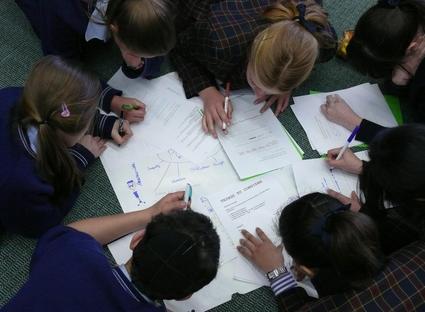So what exactly are these resolutions that are your ultimate goal? They’re basically documents full of your specific solutions to the topic in your committee. Each resolution has two parts: a section of Preambulatory Clauses (Preams) and a section of Operative (Op) clauses. Think of the first as why you’re taking a particular action, and the second as what action you’re taking. For example,
Pream: Recognizing that the refugee crisis needs to be stopped,
Op: Recommends that all Member countries accept at least 100,000 refugees in the next calendar year.
All your Preams will be grouped together at the beginning of a resolution, followed by all your Op clauses. Op clauses are usually underlined and numbered to make them clear, but can also be italicized - that’s a style point. UNA-USA has a great list of Preams and Op clauses that every delegate should print out and bring with them to committee. For some examples of real UN resolutions, check out these Security Council and General Assembly resolutions.
While you’re writing them during unmod, these documents are called Working Papers. They’ll probably start small and less detailed, as just a way to get your ideas on paper and claim them as yours. Eventually, as you merge with other people and write longer documents, you will be writing full Working Papers. These can then be introduced and debated through a Moderated Caucus.
Once you’re finished writing, you submit the document to the Chair, and it is now called a Draft Resolution. It will usually be numbered according to the topic and the order in which you submit it. So if you’re discussing the first topic, and you turn in your working paper first, it will probably be numbered 'Draft Resolution 1.1'.
It will only be called a Resolution after it passes.
Tips & Tricks
You want to show you’re a leader, so try to be the primary author on a resolution. That means most of your ideas are in it, and you will definitely get to present it during a Formal Caucus.
Be specific - make sure to address how your idea will be funded, who will carry it out, and who will be affected by it. For example, an Op clause to provide education to girls in war-torn countries could read:
Encourages Member States to pay non-profits such as Teach First to create secondary school curriculums for girls in the following countries: Syria, Iraq, Afghanistan, Sudan
By using funding from the World Bank and IMF,
By providing tax credits to people in their countries who donate to Teach First.
Make sure your resolution isn’t only about you - you should be incorporating ideas from everyone in your bloc, and backing them up with everybody’s research.
Our final point in this post is about Amendments
They’re exactly what they sound like: changes to the draft resolution you’ve already presented. Let’s take the Teach First example above. Let’s say during your presentation you get a lot of questions about why other African countries with recent conflicts like the Democratic Republic of Congo, the Central African Republic, and Libya weren’t included. You can write a Friendly Amendment to include those countries. A Friendly Amendment has to be written and submitted by a sponsor of the resolution, and they’re not voted on by the rest of the committee.
Or, if you disagree with the people asking the question, they can write an Unfriendly Amendment, since they’re not sponsors of your resolution. This amendment then has to be introduced and voted on before it’s included with your draft resolution.


